Yifan Hou
Chimera: Diagnosing Shortcut Learning in Visual-Language Understanding
Sep 26, 2025Abstract:Diagrams convey symbolic information in a visual format rather than a linear stream of words, making them especially challenging for AI models to process. While recent evaluations suggest that vision-language models (VLMs) perform well on diagram-related benchmarks, their reliance on knowledge, reasoning, or modality shortcuts raises concerns about whether they genuinely understand and reason over diagrams. To address this gap, we introduce Chimera, a comprehensive test suite comprising 7,500 high-quality diagrams sourced from Wikipedia; each diagram is annotated with its symbolic content represented by semantic triples along with multi-level questions designed to assess four fundamental aspects of diagram comprehension: entity recognition, relation understanding, knowledge grounding, and visual reasoning. We use Chimera to measure the presence of three types of shortcuts in visual question answering: (1) the visual-memorization shortcut, where VLMs rely on memorized visual patterns; (2) the knowledge-recall shortcut, where models leverage memorized factual knowledge instead of interpreting the diagram; and (3) the Clever-Hans shortcut, where models exploit superficial language patterns or priors without true comprehension. We evaluate 15 open-source VLMs from 7 model families on Chimera and find that their seemingly strong performance largely stems from shortcut behaviors: visual-memorization shortcuts have slight impact, knowledge-recall shortcuts play a moderate role, and Clever-Hans shortcuts contribute significantly. These findings expose critical limitations in current VLMs and underscore the need for more robust evaluation protocols that benchmark genuine comprehension of complex visual inputs (e.g., diagrams) rather than question-answering shortcuts.
Can Vision-Language Models Solve Visual Math Equations?
Sep 10, 2025Abstract:Despite strong performance in visual understanding and language-based reasoning, Vision-Language Models (VLMs) struggle with tasks requiring integrated perception and symbolic computation. We study this limitation through visual equation solving, where mathematical equations are embedded in images, variables are represented by object icons, and coefficients must be inferred by counting. While VLMs perform well on textual equations, they fail on visually grounded counterparts. To understand this gap, we decompose the task into coefficient counting and variable recognition, and find that counting is the primary bottleneck, even when recognition is accurate. We also observe that composing recognition and reasoning introduces additional errors, highlighting challenges in multi-step visual reasoning. Finally, as equation complexity increases, symbolic reasoning itself becomes a limiting factor. These findings reveal key weaknesses in current VLMs and point toward future improvements in visually grounded mathematical reasoning.
* Monjoy Narayan Choudhury and Junling Wang contributed equally to this work. Accepted at EMNLP2025 main. Code and datasets are open-sourced with links in the paper
Vision in Action: Learning Active Perception from Human Demonstrations
Jun 18, 2025Abstract:We present Vision in Action (ViA), an active perception system for bimanual robot manipulation. ViA learns task-relevant active perceptual strategies (e.g., searching, tracking, and focusing) directly from human demonstrations. On the hardware side, ViA employs a simple yet effective 6-DoF robotic neck to enable flexible, human-like head movements. To capture human active perception strategies, we design a VR-based teleoperation interface that creates a shared observation space between the robot and the human operator. To mitigate VR motion sickness caused by latency in the robot's physical movements, the interface uses an intermediate 3D scene representation, enabling real-time view rendering on the operator side while asynchronously updating the scene with the robot's latest observations. Together, these design elements enable the learning of robust visuomotor policies for three complex, multi-stage bimanual manipulation tasks involving visual occlusions, significantly outperforming baseline systems.
DexMachina: Functional Retargeting for Bimanual Dexterous Manipulation
May 30, 2025Abstract:We study the problem of functional retargeting: learning dexterous manipulation policies to track object states from human hand-object demonstrations. We focus on long-horizon, bimanual tasks with articulated objects, which is challenging due to large action space, spatiotemporal discontinuities, and embodiment gap between human and robot hands. We propose DexMachina, a novel curriculum-based algorithm: the key idea is to use virtual object controllers with decaying strength: an object is first driven automatically towards its target states, such that the policy can gradually learn to take over under motion and contact guidance. We release a simulation benchmark with a diverse set of tasks and dexterous hands, and show that DexMachina significantly outperforms baseline methods. Our algorithm and benchmark enable a functional comparison for hardware designs, and we present key findings informed by quantitative and qualitative results. With the recent surge in dexterous hand development, we hope this work will provide a useful platform for identifying desirable hardware capabilities and lower the barrier for contributing to future research. Videos and more at https://project-dexmachina.github.io/
DexUMI: Using Human Hand as the Universal Manipulation Interface for Dexterous Manipulation
May 29, 2025Abstract:We present DexUMI - a data collection and policy learning framework that uses the human hand as the natural interface to transfer dexterous manipulation skills to various robot hands. DexUMI includes hardware and software adaptations to minimize the embodiment gap between the human hand and various robot hands. The hardware adaptation bridges the kinematics gap using a wearable hand exoskeleton. It allows direct haptic feedback in manipulation data collection and adapts human motion to feasible robot hand motion. The software adaptation bridges the visual gap by replacing the human hand in video data with high-fidelity robot hand inpainting. We demonstrate DexUMI's capabilities through comprehensive real-world experiments on two different dexterous robot hand hardware platforms, achieving an average task success rate of 86%.
Explore the Reasoning Capability of LLMs in the Chess Testbed
Nov 11, 2024



Abstract:Reasoning is a central capability of human intelligence. In recent years, with the advent of large-scale datasets, pretrained large language models have emerged with new capabilities, including reasoning. However, these models still struggle with long-term, complex reasoning tasks, such as playing chess. Based on the observation that expert chess players employ a dual approach combining long-term strategic play with short-term tactical play along with language explanation, we propose improving the reasoning capability of large language models in chess by integrating annotated strategy and tactic. Specifically, we collect a dataset named MATE, which consists of 1 million chess positions with candidate moves annotated by chess experts for strategy and tactics. We finetune the LLaMA-3-8B model and compare it against state-of-the-art commercial language models in the task of selecting better chess moves. Our experiments show that our models perform better than GPT, Claude, and Gemini models. We find that language explanations can enhance the reasoning capability of large language models.
Adaptive Compliance Policy: Learning Approximate Compliance for Diffusion Guided Control
Oct 12, 2024



Abstract:Compliance plays a crucial role in manipulation, as it balances between the concurrent control of position and force under uncertainties. Yet compliance is often overlooked by today's visuomotor policies that solely focus on position control. This paper introduces Adaptive Compliance Policy (ACP), a novel framework that learns to dynamically adjust system compliance both spatially and temporally for given manipulation tasks from human demonstrations, improving upon previous approaches that rely on pre-selected compliance parameters or assume uniform constant stiffness. However, computing full compliance parameters from human demonstrations is an ill-defined problem. Instead, we estimate an approximate compliance profile with two useful properties: avoiding large contact forces and encouraging accurate tracking. Our approach enables robots to handle complex contact-rich manipulation tasks and achieves over 50\% performance improvement compared to state-of-the-art visuomotor policy methods. For result videos, see https://adaptive-compliance.github.io/
What Do Language Models Learn in Context? The Structured Task Hypothesis
Jun 06, 2024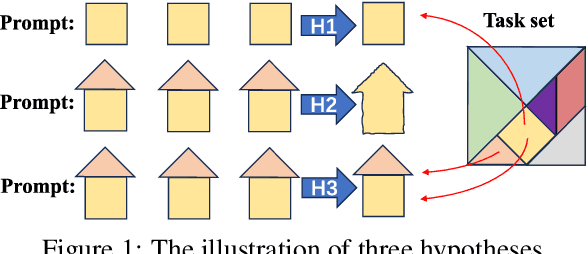


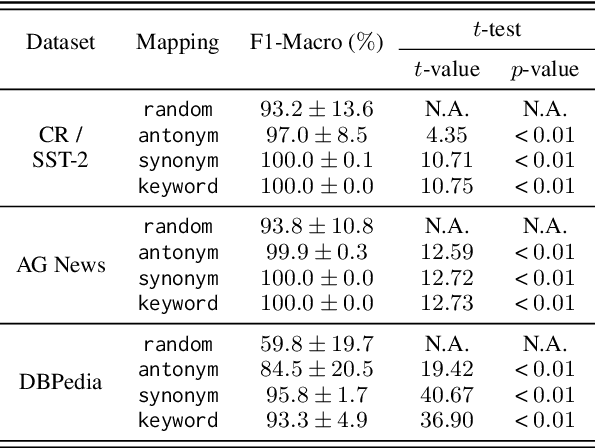
Abstract:Large language models (LLMs) exhibit an intriguing ability to learn a novel task from in-context examples presented in a demonstration, termed in-context learning (ICL). Understandably, a swath of research has been dedicated to uncovering the theories underpinning ICL. One popular hypothesis explains ICL by task selection. LLMs identify the task based on the demonstration and generalize it to the prompt. Another popular hypothesis is that ICL is a form of meta-learning, i.e., the models learn a learning algorithm at pre-training time and apply it to the demonstration. Finally, a third hypothesis argues that LLMs use the demonstration to select a composition of tasks learned during pre-training to perform ICL. In this paper, we empirically explore these three hypotheses that explain LLMs' ability to learn in context with a suite of experiments derived from common text classification tasks. We invalidate the first two hypotheses with counterexamples and provide evidence in support of the last hypothesis. Our results suggest an LLM could learn a novel task in context via composing tasks learned during pre-training.
Towards a Mechanistic Interpretation of Multi-Step Reasoning Capabilities of Language Models
Oct 23, 2023
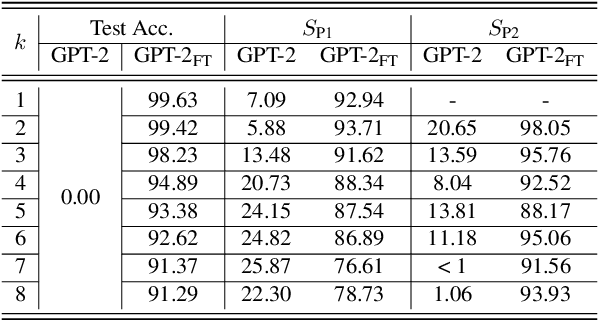

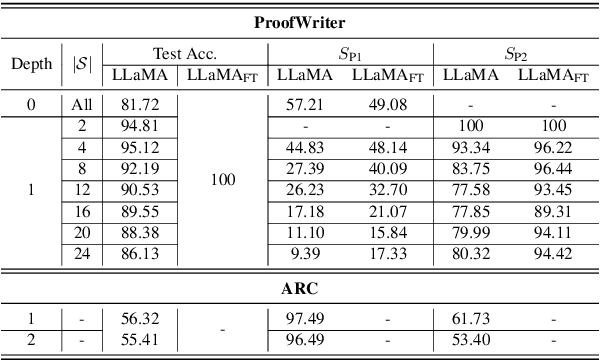
Abstract:Recent work has shown that language models (LMs) have strong multi-step (i.e., procedural) reasoning capabilities. However, it is unclear whether LMs perform these tasks by cheating with answers memorized from pretraining corpus, or, via a multi-step reasoning mechanism. In this paper, we try to answer this question by exploring a mechanistic interpretation of LMs for multi-step reasoning tasks. Concretely, we hypothesize that the LM implicitly embeds a reasoning tree resembling the correct reasoning process within it. We test this hypothesis by introducing a new probing approach (called MechanisticProbe) that recovers the reasoning tree from the model's attention patterns. We use our probe to analyze two LMs: GPT-2 on a synthetic task (k-th smallest element), and LLaMA on two simple language-based reasoning tasks (ProofWriter & AI2 Reasoning Challenge). We show that MechanisticProbe is able to detect the information of the reasoning tree from the model's attentions for most examples, suggesting that the LM indeed is going through a process of multi-step reasoning within its architecture in many cases.
simPLE: a visuotactile method learned in simulation to precisely pick, localize, regrasp, and place objects
Jul 24, 2023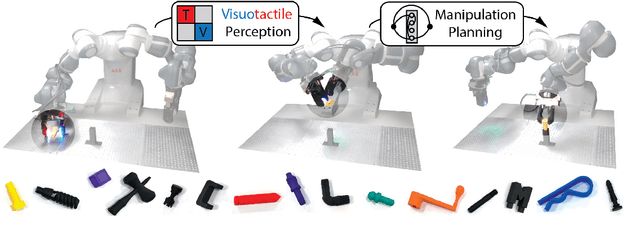
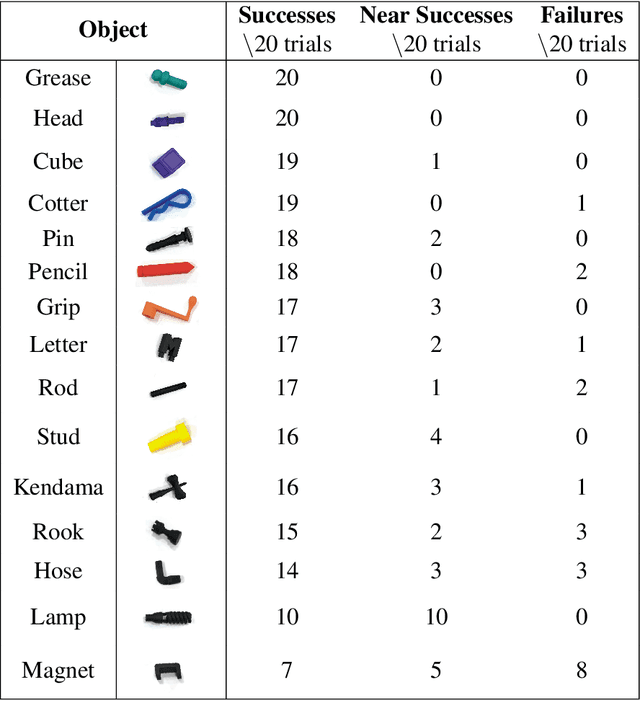
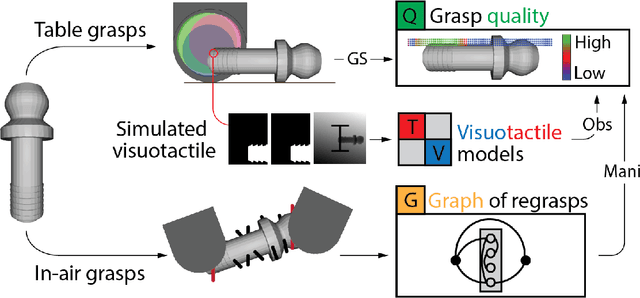
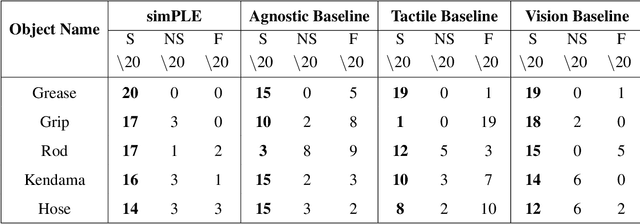
Abstract:Existing robotic systems have a clear tension between generality and precision. Deployed solutions for robotic manipulation tend to fall into the paradigm of one robot solving a single task, lacking precise generalization, i.e., the ability to solve many tasks without compromising on precision. This paper explores solutions for precise and general pick-and-place. In precise pick-and-place, i.e. kitting, the robot transforms an unstructured arrangement of objects into an organized arrangement, which can facilitate further manipulation. We propose simPLE (simulation to Pick Localize and PLacE) as a solution to precise pick-and-place. simPLE learns to pick, regrasp and place objects precisely, given only the object CAD model and no prior experience. We develop three main components: task-aware grasping, visuotactile perception, and regrasp planning. Task-aware grasping computes affordances of grasps that are stable, observable, and favorable to placing. The visuotactile perception model relies on matching real observations against a set of simulated ones through supervised learning. Finally, we compute the desired robot motion by solving a shortest path problem on a graph of hand-to-hand regrasps. On a dual-arm robot equipped with visuotactile sensing, we demonstrate pick-and-place of 15 diverse objects with simPLE. The objects span a wide range of shapes and simPLE achieves successful placements into structured arrangements with 1mm clearance over 90% of the time for 6 objects, and over 80% of the time for 11 objects. Videos are available at http://mcube.mit.edu/research/simPLE.html .
 Add to Chrome
Add to Chrome Add to Firefox
Add to Firefox Add to Edge
Add to Edge